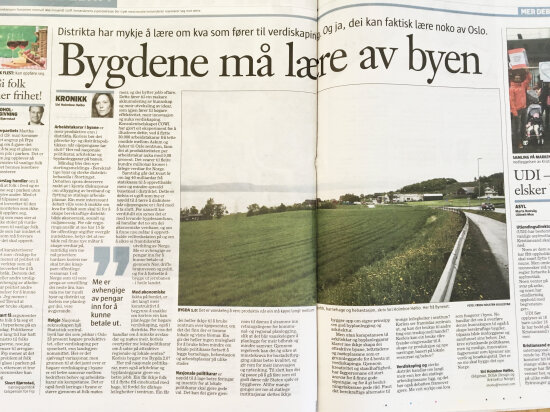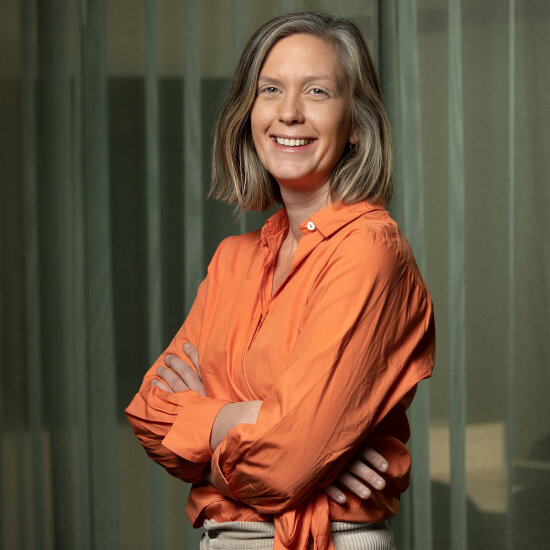The new White Paper ‘Sustainable Cities and Strong Districts’ was presented to the Norwegian Parliament on Monday. Unfortunately, the debate quickly derailed into the usual discussions of the expansion of the broadband network and relocation of government jobs. A more interesting debate would have been to talk about the types of measures that are needed to create sustainable rural areas from an economic, social and environmental perspective. After all, when the government estimates that we have 15 years before public expenditures surpass revenues, we will need to find new ways to create value, while at the same time make tough decisions in prioritising increasingly scarce public resources. In a country that will be undergoing extensive restructuring in the years to come, the choices we make regarding urban and rural districts and how we plan them will make or break us.
According to the National Accounts division at Statistics Norway, those who work in Oslo represent a 23 percent higher productivity level, or value creation per employee, than the national average. Obviously, there are variations in productivity levels, but the reason that value creation in the cities is higher on average is due to better compatibility between company needs and employee expertise. Another reason is that greater learning takes place in cities because people have more contact with one another and switch jobs more often. This leads to a more rapid accumulation of knowledge and more sharing of ideas, which in turn leads to greater effectiveness, more innovation and increased value creation. The COWI consultancy firm carried out an experiment to illustrate this that entailed relocating 20,000 employees from the populated area between Askim and Asker to the centre of Oslo. This resulted in an increase of productivity per employee of 0.08 percent. This corresponds to several hundred million Norwegian crowns in annual value for the country.
After all, if the goal is to reduce distances and facilitate more encounters between people, how can we convince local politicians to dedicate efforts to creating more attractive regional and local centres?
At the same time, the government spends around 40 billion crowns each year to maintain a more spread-out rural population This is an expenditure we will have to discuss as the oil era comes to an end. After all, as valuable as a viable rural society may be, economic values are also important, as are new ways to maintain our welfare state and ensure a future-oriented development of Norway. We are dependent on revenues in order to pay benefits through NAV, maintain fire brigades and police stations and to continue expanding our railway network – throughout the entire country.
Considering the economic facts, it is far more constructive to start discussing how to facilitate higher value creation, also in rural areas. After all, if the goal is to reduce distances and facilitate more encounters between people, how can we convince local politicians to dedicate efforts to creating more attractive regional and local centres? How can we create Countryside 2.0?
National politicians, as well as architects and city planners, need to do a better job. People are simply not interested in relocating from a single family home with a garden to an unattractive apartment in the centre, nor can you get people to shop in a town centre instead of a shopping centre if all they encounter there are vacant buildings and wilting flowers. And they will have no incentive to drive less if local politicians continue to build day-care centres, health care centres and workplaces at different locations.

Photo: Eirik Evjen
National politicians are going to have to provide better guidelines and incentives that put pressure on local politicians to make the right decisions. This can be done by implementing more restrictive guidelines for municipal and regional planning, making it more difficult to facilitate more car use and less contact between people. They can also use regulations to ensure that the minimum requirements for housing developments ensure better quality and more opportunity for innovation and new approaches. Finally, they can also make sure to serve as a good example when the government is in charge of developments. We see far too often that government institutions are far from based on the principles of good urban planning and architecture.
But without the expertise of architects and urban planners, we cannot create the attractive cities, towns or meeting places that are essential to value creation. Through creativity and perseverance, specialists have a major responsibility to find effective solutions and provide decision-makers with good advice. Are sustainable alternatives available to cramped apartments in the city centre? What does the town centre of the future look like and can it be used for things other than traditional commerce? How can our physical spaces be used to create new production and new types of business based on local resources and needs?
Value creation and strong rural areas are about much more than the location of government jobs and the debate on these topics should be equally as complex. We know much about what works in the city. We now need to apply this knowledge to creating sustainable small towns that are tailored to both residents and societal needs. This requires innovative politicians, as well as innovative experts with the courage to recognise their own value and opportunities. Now is the time to build the Norway of tomorrow.

